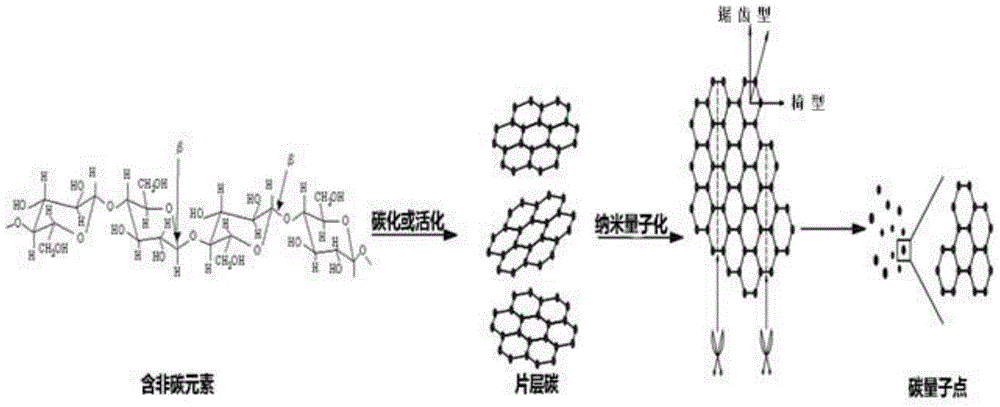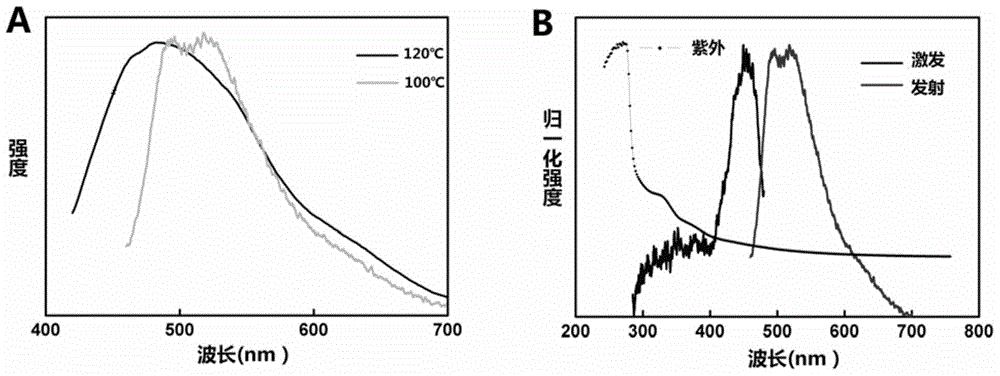Method for preparing biomass based carbon quantum dots
A carbon quantum and biomass-based technology, applied in chemical instruments and methods, nanotechnology, nano-optics, etc., can solve the problems of limited performance of carbon quantum dots, high equipment requirements, complicated steps, etc., and achieve good green fluorescence effect, Simple preparation process and wide-ranging effects
- Summary
- Abstract
- Description
- Claims
- Application Information
AI Technical Summary
Problems solved by technology
Method used
Image
Examples
Embodiment 1
[0033] Pre-oxidize walnut shells soaked with a catalyst (a mixture of urea and phosphoric acid at a molar ratio of 2:1) in air at 100°C, 150°C, and 250°C for 30 minutes, then place them in a tube-type high-temperature electric furnace, and blow nitrogen Protection, 350°C, 600°C, 800°C for 20 minutes, take it out for later use.
[0034] Weigh 0.3g of carbonized raw material, disperse in a mixture of 20ml of nitric acid and 60ml of concentrated sulfuric acid, and ultrasonicate at room temperature for 2h. Reflux at 80°C for 24 hours, and the concentrated acid mixture quantizes the sheet-layer carbon structure into carbon quantum dots. After the reaction, cool to room temperature, dilute 10 times, adjust the pH of the solution to 7 with sodium carbonate, filter with a 0.22 μm microporous filter head, and dialyze with a 2000 Da dialysis bag for 3 days to remove salt and other components and impurities to obtain yellow fluorescent carbon quantum The aqueous solution of the point, t...
Embodiment 2
[0037] Pre-oxidize walnut shells soaked with a catalyst (a mixture of urea and phosphoric acid at a molar ratio of 2:1) in air at 100°C, 150°C, and 250°C for 30 minutes, then place them in a tube-type high-temperature electric furnace, and blow nitrogen Protection, 350°C, 600°C, 800°C for 20 minutes, take it out for later use.
[0038] Weigh 0.3g of carbonized raw material, disperse in a mixture of 20ml of nitric acid and 60ml of concentrated sulfuric acid, and ultrasonicate at room temperature for 2h. Reflux at 100°C for 24 hours, and the concentrated acid mixture quantizes the sheet-layer carbon structure into carbon quantum dots. After the reaction, cool to room temperature, dilute 10 times, adjust the pH of the solution to 7 with sodium carbonate, filter with a 0.22 μm microporous filter head, and dialyze with a 2000 Da dialysis bag for 3 days to remove salt and other impurities to obtain green fluorescent carbon quantum The aqueous solution of the point, the product size...
Embodiment 3
[0042] Pre-oxidize walnut shells soaked with a catalyst (a mixture of urea and phosphoric acid at a molar ratio of 2:1) in air at 100°C, 150°C, and 250°C for 30 minutes, then place them in a tube-type high-temperature electric furnace, and blow nitrogen Protection, 350°C, 600°C, 800°C for 20 minutes, take it out for later use.
[0043] Weigh 0.3g of carbonized raw material, disperse in a mixture of 10ml of nitric acid and 30ml of concentrated sulfuric acid, and ultrasonicate at room temperature for 2h. Reflux at 80°C for 24 hours, and the concentrated acid mixture quantizes the sheet-layer carbon structure into carbon quantum dots. After the reaction, cool to room temperature, dilute 10 times, adjust the pH of the solution to 1 with sodium carbonate, filter with a 0.22 μm microporous filter head, and dialyze with a 2000 Da dialysis bag for 3 days to remove salt and other components and impurities to obtain yellow fluorescent carbon quantum The aqueous solution of the point, t...
PUM
| Property | Measurement | Unit |
|---|---|---|
| size | aaaaa | aaaaa |
Abstract
Description
Claims
Application Information
 Login to View More
Login to View More - R&D
- Intellectual Property
- Life Sciences
- Materials
- Tech Scout
- Unparalleled Data Quality
- Higher Quality Content
- 60% Fewer Hallucinations
Browse by: Latest US Patents, China's latest patents, Technical Efficacy Thesaurus, Application Domain, Technology Topic, Popular Technical Reports.
© 2025 PatSnap. All rights reserved.Legal|Privacy policy|Modern Slavery Act Transparency Statement|Sitemap|About US| Contact US: help@patsnap.com



